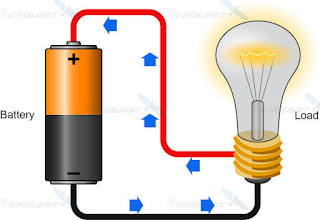Science textbook Solutions for Class 8 Science Chapter 4 – Current Electricity and Magnetism
Important points to remember :
- This electric level deciding the direction of flow of electric charges is called electrostatic potential.
- Potential difference : Similar to the height of a waterfall, the temperature difference of hot and cold bodies, the difference between the potential of two points,
- Lithium ion cells are used in modern equipments for example smart phone, laptop etc.
- These cells can be recharged. More electrical energy can be stored in these cells as compared to that in Nicd cells.
Question 1: Write proper words from the following group of words in the blanks.
(magnetism, 4.5V, 3.0V, gravitational attraction, potential differences, potential, higher, lower, 0V)
A. Water in the waterfall flows from a higher level to the lower level because of potential differences.
B. In an electric circuit, electron flow a from of point of higher potential to the point of lower potential.
C. The differences between the electrostatic potential of the positive end the negative end of an electric cell is the potential of the cell.
D. Three electric cells of potential difference 1.5 V each have been connected as a battery. The potential differences of the battery will be 1.5 + 1.5 + 1.5 = 4.5 V.
E. An electric current flowing in a wire creates magnetic field around the wire.
Question 2: A battery is to be formed by joining 3 dry cells with connecting wires. Show how will you connect the wires by drawing a diagram.
Answer :
Question 3: In an electric circuit, a battery and a bulb have been connected and the battery consists of two cells of equal potential difference. If the bulb is not glowing, then which tests will you perform in order to find out the reason for the bulb not glowing?
Answer :
- Check how the terminals of the batteries are connected to each other:
- Ensure that the positive terminal of one battery is connected to negative terminal of other battery. If the batteries are connected in this this way and even then the bulb does not glow, go for the next test given below.
- Check for the broken wires in the circuit: Ensure that the wires used for connecting the various electrical components are nor broken in between i.e. ensure that the circuit is closed. Even after ensuring that the wires are not broken in between, the bulb does not glow, move to the next test.
- Check how the connecting wires are connected to the bulb: Ensure that the bulb is connected to the batteries using the connecting wires as shown below. Even now, if the bulb does not glow, replace the bulb or the batteries with a new one.
Question 4: Electric cells having 2 V potential difference each have been connected in the form of a battery. What will be the total potential difference of the battery in both cases ?
Answer :
i) Total potential difference = 2 + 2 + 2 = 6 V
(ii) Total potential difference = 2 + 2 + 2 + 2 = 8 V
Question 5: Describe the construction, working and usefulness of a dry cell, with the help of a diagram.
Answer :
- Take a lead dry cell and remove its outer coating. Inside you will find a whitish, metal layer. This is the Zinc (Zn) metal layer.
- This is the negative terminal of the cell. Now, carefully break open this layer. There is another layer inside. An electrolyte is filled between these two layers. The elctrolyte contains negatively charged and positively charged ions. These are the carriers of electricity.
- The electrolyte is a wet pulp of Zinc chloride (ZnCl2) and Ammonium chloride (NH4Cl). There is a graphite rod at the centre of the cell. This is positive terminal of the cell. A paste of Manganese dioxide (MnO2) is filled outside the rod. Because of the chemical reactions of all these chemicals, electrical charge is produced on the two terminals (graphite rod and zinc layer) and an electric current flows in the circuit.
- Due to the wet pulp used in this cell, the chemical reaction proceeds very slowly.
- Hence a large electric current can not be obtained from this. Compared to the electric cells using liquids, the shelf life of dry cells is longer.
- Dry cells are very convenient to use as these can be held in any direction with respect to ground and can be used in mobile instruments.
Question 6: Describe the construction and working of an electric bell with the help of a diagram.
Answer :
- A copper wire is wound around an iron piece. This coil acts as an electromagnet. An iron strip along with a striker is fitted near to the electromagnet.
- A contact screw is in touch with the strip.
- The current flows in the circuit when screw is in contact with the strip, and hence the coil becomes a magnet and attracts the iron strip towards it.
- Therefore, the striker hits the gong and the sound is created. However, at the same time, the contact screw loses the contact with the strip and the current in the circuit stops.
- In this situation, the electromagnet loses its magnetism and the iron strip moves back and comes in contact with the contact screw.
- The electric current is then immediately restored and again the striker hits the gong by the above process. This action repeats itself and the bell rings.
Tags : electricity and magnetism class 7 icse, magnetism class 11, electricity and magnetism physics, notes on electricity and magnetism, difference between electricity and magnetism, magnetism electricity and electronics tnpsc, science digest std 8 maharashtra board, electricity and magnetism icse class 9


